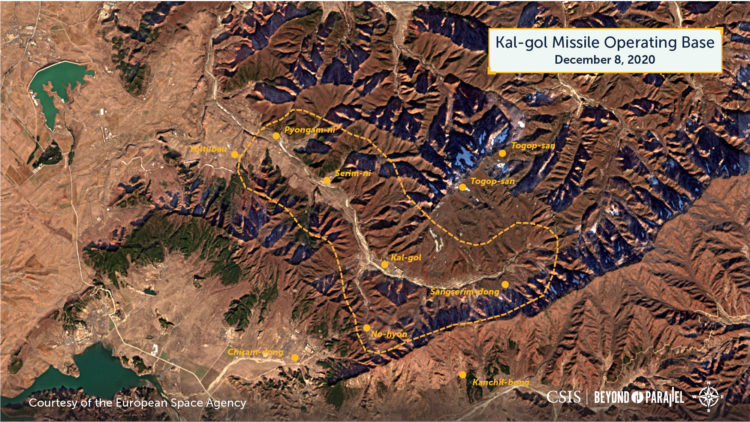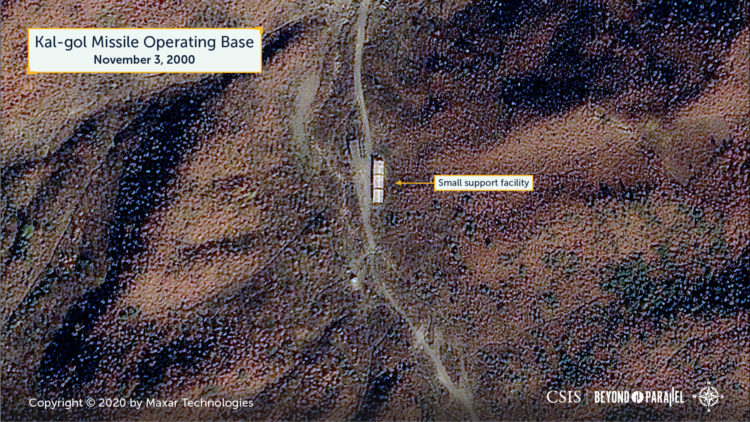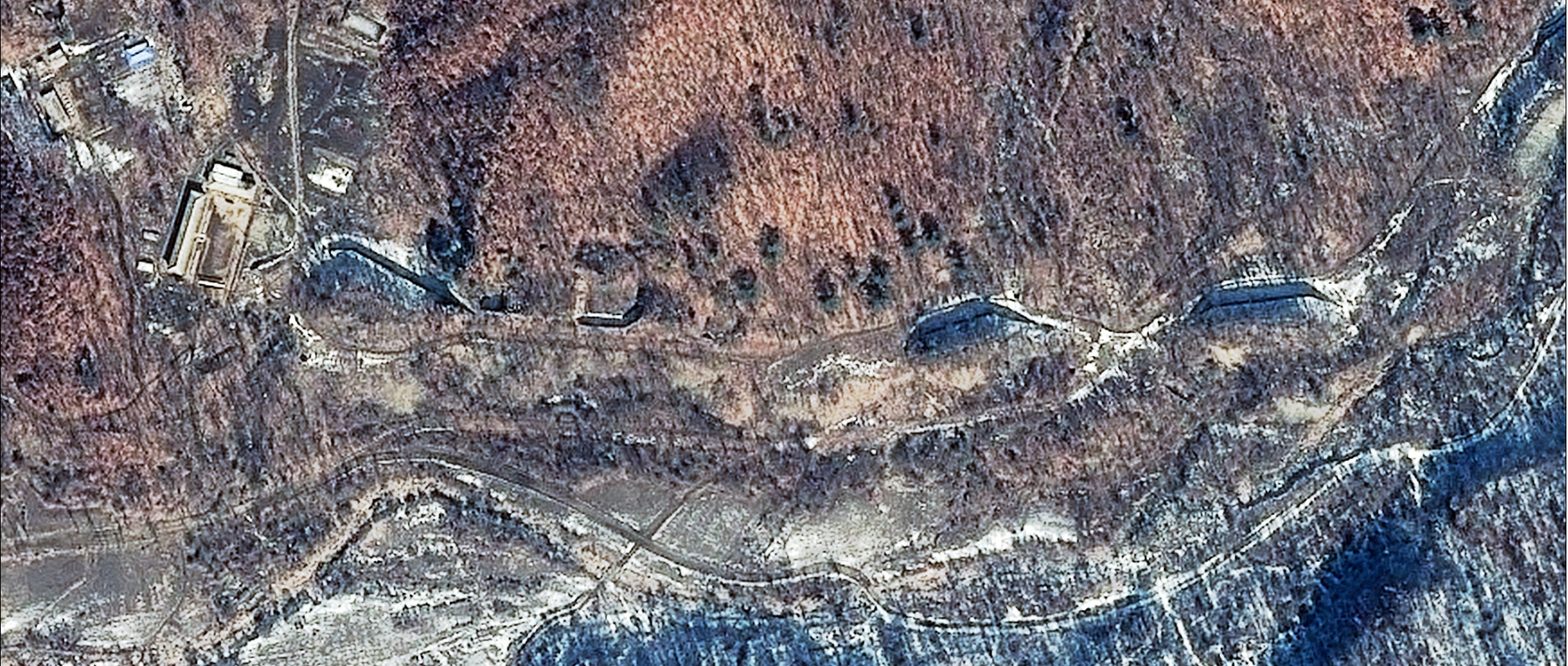
Undeclared North Korea: The Kal-gol Missile Operating Base
This report has been updated as of January 12, 2021.

Key Findings
- Located approximately 52 kilometers north of the DMZ and 125 kilometers north of Seoul, the Kal-gol missile operating base is one of the most developed of North Korea’s approximately 15-20 undeclared ballistic missile facilities.1
- This base likely houses a reinforced brigade-sized unit equipped with 500-kilometer-range Hwasong-6 (Scud C) short-range ballistic missiles (SRBM) or Hwasong-9 (Scud-ER) medium-range ballistic missiles (MRBM).
- In a conflict, North Korea would use Hwasong-6 missiles to strike targets throughout South Korea and Hwasong-9 missiles to strike U.S. bases and other civilian targets in the southern half of Japan.
- A specialized drive-through building with an arched clearstory allows for the elevation of a Hwasong-5/-6 missile on a TEL or MEL for training and maintenance. This increases the time launchers can be stowed away from their parent units for repairs or upgrades and therefore increases portability in a launch scenario.
- Kal-gol currently contains ten Underground Facilities which could house missiles and nine to twelve transporter-erector-launchers (TEL) and mobile-erector-launchers (MEL) of various sizes, and three drive-through facilities (two hardened against preemptive attack). It has been continuously developed during the past 25 to 30 years.
- Recent images from December 2020 indicate that the base is not only active and being well-maintained by North Korean standards, but also that during the past two years it has continued to be developed.
- Along with the bases at Sakkanmol and Kumchon-ni, Kal-gol forms the North’s forward (or tactical) ballistic missile belt, a component of an extensive nation-wide dispersed ballistic missile network, including bases located at Sino-ri, Sangnam-ni, and Yusang-ni that CSIS has documented.
- North Korean missile operating bases have never been subject to declaration, verification, and dismantlement in any previous denuclearization agreement despite the obvious threat their continued operations pose to U.S. and allied military on the peninsula, in Japan, and in the Pacific.

The Kal-gol (갈골) ballistic missile operating base is located in Koksan-gun (곡산군, Koksan County), Hwanghae-bukto (황해북도, North Hwanghae Province), approximately 52 kilometers north of the DMZ and 125 kilometers north of Seoul—the capital of South Korea.2 Although occasionally and inaccurately referred to as being an “underground missile storage” facility or having “underground launch pads” it is a forward ballistic missile operating base that has underground facilities (UGF) that house ballistic missile transporter-erector-launchers (TEL) or mobile-erector-launchers (MEL) that during wartime will exit the base to conduct launch operations.3 The base is subordinate to the Korean People’s Army’s (KPA) Strategic Force, which is responsible for all ballistic missile units.
Kal-gol, along with the bases at Sakkanmol and Kumchon-ni, form North Korea’s forward (or tactical) ballistic missile belt, a component of an extensive nation-wide dispersed ballistic missile network. The base is unique in that it is the only ballistic missile operating base that currently contains a clearstory maintenance/training building, has ten UGFs of various sizes, three drive-through facilities (two of which are hardened) and has continued to be developed during the past 20 years.
Since 1990, the unit located at the base has been variously reported as operating the North Korean manufactured 300-kilometer-range Hwasong-5 (R-17E Scud B), the 500-kilometer-range Hwasong-6 (Scud C) short-range ballistic missiles (SRBM), and the 1,000-kilometer-range Hwasong-9 (Scud-ER) medium-range ballistic missile (MRBM).4 While the Hwasong-5 provides the Kal-gol missile unit with the capability to strike the northern half of South Korea, assuming Cheju-do (제주도 or Jeju-do) is included, the Hwasong-6 allows the unit to strike all of South Korea including Cheju-do. If equipped with the longer-range Hwasong-9, the threat envelope would be extended to allow for the delivery of a 750-kilogram warhead to all of South Korea and the southern half of Japan (e.g., Kyushu, Shikoku and a large portion of Honshu)—an area that includes a number of bases used by the U.S. military. Should the missile unit based at Kal-gol be equipped with a more recently emerging medium-range ballistic missile (MRBM) such as the 1,200-2,000-kilometer solid rocket motor Pukkuksong-2, the threat envelope would extend to cover all of Japan, including U.S. military bases on Okinawa and beyond.5 Alternately, the base could be re-equipped with the newer KN-23/-24/-25 solid rocket motor SRBMs, which would provide it with greater survivability and retain capabilities similar to those of the Hwasong-5/-6.
All satellite imagery from 2000 onwards indicates that the base is active and being well-maintained by North Korean standards. Significantly, this imagery also shows that it is continuing to be developed.
Development
During the late-1980s and early-1990s, with the increased availability of Hwasong-5, transporter-erector launchers (TEL) and mobile-erector-launchers (MEL), the KPA reorganized those units operating the system into several reinforced battalion- and regiment-sized units. Some of these units were deployed to three newly established forward ballistic missile operating bases south and east of the capital of Pyongyang—Sakkanmol and Kal-gol in Hwanghae-bukto and Kumchon-ni in Kangwon-do.6 The locations chosen for these new missile bases were mountainous areas forward enough to provide coverage of critical facilities in the northern half of South Korea, yet far enough to the rear to be out of range of South Korean and U.S. long-range artillery.
As best as can be presently determined construction of the actual Kal-gol missile operating base began during the mid-to-late 1980s using specialized engineering troops from KPA Unit No. 583 (the cover designator of the Military Construction Bureau).7 This appears to have been somewhat earlier then the start of construction on the Sakkanmol and Kumchon-ni missile operating bases. The site chosen for the base appears to have been an existing KPA installation known up to that time by US intelligence as the “Chilchon Military Barracks East” that housed a mechanized infantry battalion.8 It is, however, unclear when the present day Kal-gol base actually became operational.
It is also unclear, given the repeated references to a ballistic missile unit being located in the Singye, To-gol, or Koksan areas, whether the newly established Scud missile unit was immediately deployed to the base formerly occupied by the mechanized infantry battalion or if it was deployed somewhere nearby. Regardless, the unit was, at a minimum, operational in the area by 1988 as is indicated by a 1993 briefing by the South Korean Defense Ministry. In this briefing a spokesperson stated that in 1988 North Korea deployed Scud-C missiles in Singye-gun, North Hwanghae Province.”9 Singye-gun is only 7-kilometers southwest of the Kal-gol base, while the small city of Singye is only 25.5 kilometers to the southwest. Along with To-gol, also in Singye-gun and 14 kilometers to the southwest of the Kal-gol base, these two locations were often cited in published reports during the 1990s referring to the Kal-gol Scud missile unit.10 For example, a May 1990 report describes missile ballistic launch preparations near the town of To-gol,
“…a modified Soviet Scud B, was photographed for the first time in May by a U.S. spy satellite as it was being set up for launching on a peninsula along North Korea’s east coast, near the town of To-kol, intelligence sources said. Subsequent photos revealed that the missile had disappeared from the launch pad… U.S. intelligence craft monitoring the region for the test saw no signs that a missile had been launched… ‘The judgment is that it blew up on the launch pad,’ said one U.S. official.”11
This same report also notes, “Intelligence photos also revealed recently that two suspected ballistic missile bases are under construction along the demilitarized zone separating North Korea and South Korea” in apparent references to the Sakkanmol and Kumchon-ni missile operating bases.12
During October 1991, the director of South Korea’s Agency for National Security Planning (now the National Intelligence Service), So Tong-kwon (Suh Dong-kwon), stated that North Korea had successfully launched a Scud C from a base in Kangwon-do during July of that year. While some have suggested that this missile was fired by the unit based at Kal-gol, it was more likely launched by the units based at Kumchon-ni or Kittae-ryong.13
During February 1996, the South Korean National Security Planning Agency reported that the unit based at “Togol” consisted of a “Scud missile brigade [with] 27 Scud missiles.”14 This description indicates a brigade-sized unit with nine TELs or MELs that is organized into three battalions, with each battalion having three launchers, one ready missile and two reserve missiles.15
By the late-1990s public statements were accurately identifying the Kal-gol missile operating base as such, stating that the unit based there was soon to be equipped with Hwasong-6 (Scud C) ballistic missiles—replacing Hwasong-6 (Scud B) systems.16 Typical of these was,
According to materials that the Ministry of National Defense submitted to [a] member of Hanara Party (Grand National Party) Suh Chung-won on September 28, 1999, the launch bases of the Scud C missiles that North Korea plans to deploy near the military demarcation line is located in Kumchon-ri, Kangwon Province; Sakkanmol, Hwanghae Province; and Kalgol, Hwanghae Province…17

Three years later, South Korea authorities indicated that the same unit “…comprises three battalions and has deployed around 40 500-550-kilometer range Scud-C missiles.”18 That the ongoing process of re-equipping the unit based at Kal-gol with Hwasong-6 missiles may have proceeded slowly is suggested by 2001 report.19
A June 2006 statement by a South Korea official reaffirmed that, “There are five launching bases, including Togol [Kalgol] Scud Brigade in Singye, North Hwanghae Province.20
Following Kim Jong-un’s ascension to power in December 2011, he instituted widespread changes throughout the KPA emphasizing realistic training, demonstrable capabilities, and increased operational readiness. These changes soon resulted in the reorganization of the Strategic Rocket Command into the Strategic Force during 2013. At the Kal-gol missile operating base, these changes were reflected by infrastructure developments including the construction of a second hardened drive-through missile checkout facility, construction of a specialized clearstory missile maintenance and training building, and the excavation of what appears to have been four TEL revetments for training. Further development occurred during 2019 with the construction of new protected vehicle storage areas, a drive-through structure and small support facility on the south side of the main headquarters area.
As of December 11, 2020, satellite imagery indicates that the Kal-gol missile operating base is not only active and being well-maintained by North Korean standards, but also that during the past two years it has continued to be developed.
Base Organization21
The Kal-gol missile operating base is located in a bifurcated valley at the base of Togop-san (Togop Mountain, 덕업산). It encompasses approximately 9.5 square kilometers and extends about 6.7 kilometers up the valley from west to east past the small farming villages of Yoltubau (열두바우), Serim-ni (세림리), Kal-gol (from which is gets its current name), Sangserim-dong (상세림동) and No-hyon (노현).22 It is bisected by the upper reaches of the Koksan-chon (Koksan River). About halfway up the valley a small branch valley extends to the south towards the village of No-hyon. Much of the area encompassed by the base consists of unoccupied forested mountains with small agricultural support activities.
The base can be functionally separated into four broad activities: agricultural support (i.e., small cultivated fields and a small fish farm) with civilian housing, main base (including headquarters, barracks, vehicle maintenance and storage and a variety of small support elements), missile support, and underground facilities. While most of these are typical of KPA bases throughout the country the missile support facilities, size and number of underground facilities and ongoing development are noteworthy.
The earliest available commercial high-resolution satellite imagery shows that during 2001-2003, the main access road to the base was rebuilt, straightened and widened. At the same time a small entrance/checkpoint was built near Yoltubau at the base of the valley. Sometime between 2003-2005, a small monument was erected 1.1 kilometers east of the entrance/checkpoint on the main access road. Subsequently, during 2010-2011, a combination irrigation ditch/pipeline/fence was built across the valley floor immediately west of the entrance/checkpoint that more clearly delineated the base from the general area. Over the years what appears to be a small barracks area at Pyongam-ni, immediately north of the entrance/checkpoint, was gradually razed.


While agricultural activities are primarily located at the bottom of the valley in the areas around the villages of Yoltubau, Pyongam-ni, and Serim-ni, additional small cultivated fields are observed in the upper valley and on the hillsides around the villages of No-hyon and Sangserim-dong.
Approximately 1.7 kilometers up the valley is the village of Serim-ni (sometimes identified as Oya-dong), which up until about 2012 consisted of civilian housing and small agricultural fields on the south side of the Koksan-chon. While on the north side of the river there were what may be a government building or school and several small buildings that appeared to be used for small livestock rearing, and a fish farm (since 2018). During November 2012, however, satellite imagery showed that construction was underway for a new missile support facility with four structures. Most notable among these structures was the construction of a specialized drive-through building measuring approximately 31.5-meter-by-11.5-meter with an arched clearstory that reaches a height of approximately 13-15 meters.23. This height allows for the elevation of a Hwasong-5/-6 missile (and potentially the 13.5-meter-long Hwasong-9 (Scud-ER) depending upon the level of the floor) on a TEL or MEL for both training (especially during the harsh winter months) and maintenance.24 The latter would ease the burden of depot-level maintenance requiring a TEL or MEL having to be sent back to the factory for repairs or upgrades and reduces the length of time that a launcher is away from its parent unit. However, this clearstory building is too small for larger missile systems such as the Hwasong-12, -14, and -15. Such training and maintenance responsibilities suggest the presence of a reinforced brigade-sized unit with attached support units.25

The southeast section of Serim-ni as it appeared on November 3, 2000 (Copyright © 2020 by Maxar Technologies) 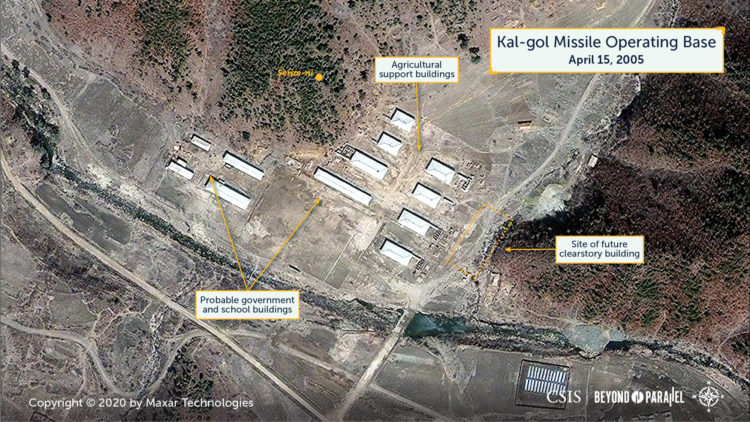
The same area as it appeared on April 15, 2005 showing the construction of what appears to be a government building or school and several buildings (Copyright © 2020 by Maxar Technologies) 
The newly erected clearstory and support buildings, November 29, 2017 (Copyright © 2020 by Maxar Technologies) 
The clearstory and support buildings, February 9, 2020 (Copyright © 2020 by Maxar Technologies)
This Kal-gol clearstory building is smaller in size but similar in design to those on two of the construction halls at the No. 65 Factory in Chonchon (전천읍, 40.636137, 126.439019), Chagang-do (자강도, Chagang Province), that were modified during late-2006.26Those halls were first used for the conversion of truck chassis into TEL/MELs and subsequently for the conversion of Chinese-manufactured WS51200 chassis to serve as TELs for the Hwasong-10, -13 -14 and -15.27 These types of clearstory structures are rarely observed outside the No. 65 Factory and Kal-gol.


Moving 1.4 kilometers further up the valley and on the north side of the Koksan-chon, is the main base consisting of the headquarters area and three barracks compounds. On the south side of the Koksan-chon are the entrances to four underground facilities and a vehicle maintenance and storage facility. The earliest commercial satellite image from November 3, 2000 shows the original headquarters buildings and new headquarters area under construction. The area continued to be developed through 2018 when a new cultural/education hall was erected. Since that time, it has remained generally unchanged.

The main headquarters area as it appeared on November 3, 2000 (Copyright © 2020 by Maxar Technologies) 
The same area as it appeared on April 9, 2010 showing the progress on constructing new headquarters buildings (Copyright © 2020 by Maxar Technologies) 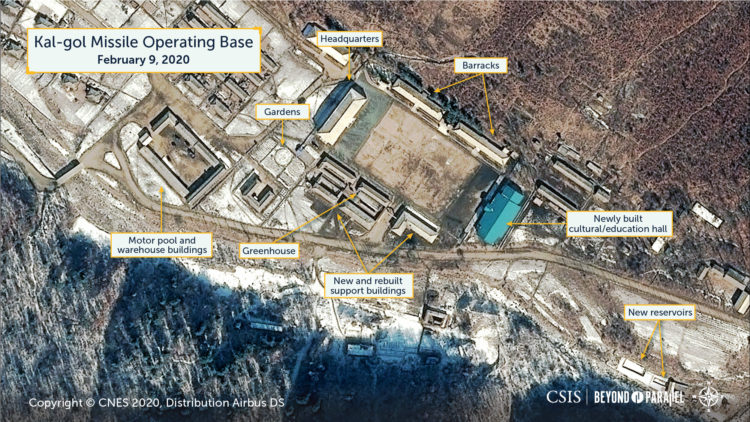
The main headquarters area as it appeared on February 9, 2020 (Copyright © 2020 by Maxar Technologies)
The main headquarters area consists of headquarters and administration buildings, cultural/education hall, parade ground (also used as a soccer pitch), gardens, motor pool/warehouse, small barracks and support areas, greenhouses, and reservoirs. In a November 28, 2017 image, approximately 1,100-1,300 troops are seen in formation on the headquarters parade ground—indicating a reinforced brigade sized unit (see below). To the east of the main headquarters are two additional barracks compounds with support buildings, greenhouses and several reservoirs. A number of the smaller facilities within the main base area have witnessed ongoing development since 2000.



The four UGF entrances (identified in this report as Nos. 1-4) located on the south side of the Koksan-chon appear to be for small facilities and do not appear to be heavily used in the imagery from 2000 to present. It is unclear, but these may date to the period before the area was converted into a missile operating base. Due to the growth of vegetation over the years, and their location on the south side of the valley, these UGF entrances are very difficult to see in almost all available satellite imagery.

A close-up view of the area where UGF entrances Nos. 1 and 2 are located, April 9, 2010 (Copyright © 2020 by Maxar Technologies) 
A close-up view of the area where UGF entrances Nos. 1 and 2 are located, December 3, 2019 (Copyright © 2020 by Maxar Technologies) 
A close-up view of the area where UGF entrances Nos. 3 and 4 are located, April 9, 2010 (Copyright © 2020 by Maxar Technologies) 
A close-up view of the area where UGF entrances Nos. 3 and 4 are located, December 3, 2019 (Copyright © 2020 by Maxar Technologies)
Further to the east, during 2019-2020, the KPA undertook development of a 480-meter-long support area on the side of the Koksan-chon. This included the construction of what appear to be,
- Three approximately 9-by-12-meter earth-bermed revetments
- An approximately 9-meter-by-15-meter earth-bermed drive-through structure
- A small support facility of unknown function cut into the slope of the valley
- What appear to be three new vehicle storage areas cut into the southern slopes of the valley—it is unclear from available imagery if these lead to bunkers or UGFs. Approximately 5-7 meters in front of each area is an oblong rock and dirt berm apparently built from the debris removed while excavating the revetments. These berms are approximately 5-10 meters high, 21-28 meters long and intended to help protect the entrance from artillery fire and aerial attack.
The new vehicle storage areas are also extremely difficult to see in satellite imagery due to their small size and being in the shadow of the southern slope.


Finally, on the east side of the main base area is a vehicle maintenance and storage facility. It was reconfigured sometime about 2000. Then again during 2010, 2014 and 2016. It has undergone only minor changes since that 2016. For example, satellite imagery from November 29, 2017 and April 9, 2018 shows two objects within this facility that appear to be two MAZ-543 TELs or MELs under camouflaged tarps. However, it is highly unlikely that TELs would be left out in the open for five months. It is more likely that these objects were simply covered building supplies. Another image, this time from May 7, 2019 shows a “Figure 8” driver training course in the facility’s main yard.

The original vehicle maintenance and storage facility, November 3, 2000 (Copyright © 2020 by Maxar Technologies) 
The new vehicle maintenance and storage facility, April 9, 2010 (Copyright © 2020 by Maxar Technologies) 
The vehicle maintenance and storage facility as of November 3, 2020 (Copyright © CNES 2020, Distribution AIRBUS DS)


Along the upper reaches of the valley, in the area of Sangserim-dong, are entrances to six large UGFs (identified in this report as Nos. 5-10), a hardened drive-through missile checkout facility and a small support facility.
The UGF entrances are located on the north side of the Koksan-chon at the foot of Togop-san and are present in all imagery since 2000. They were likely built during the late-1980s or 1990s with the establishment of the base as declassified KH-4B and KH-9 imagery from the 1960s and 1970s shows no evidence of them. The entrances are spaced between 100-200 meters apart, measure 9-meters wide and are secured by two outward opening doors. Approximately 16-18 meters in front of each entrance is an oblong rock and dirt berm built from the debris removed while excavating the UGFs. These berms are approximately 10-15 meters high, 65-120 meters long and intended to help protect the entrance from artillery fire and aerial attack. While the area between the UGF entrances and the protective berms in front of them is large enough to accommodate a TEL/MEL for a missile launch under emergency conditions, KPA tactics and doctrine call for the TELs/MELs and support vehicles to disperse from their bases during wartime launch operations. It is uncertain whether the various adjacent UGF tunnels are internally connected so that vehicles (i.e., TEL/MELs) can drive through them. At a minimum, however, some are likely linked by small internal connecting tunnels following typical KPA practice. The size of entrances—as well as known KPA practices and volume of spoil removed—indicates that these tunnels could easily house all the unit’s TEL/MELs, reload vehicles, other vehicles, and supplies. No significant changes to the hardened drive-through missile checkout facility or the UGF entrances and their associated protective berms have been observed since the 2000 image was acquired.

UGF entrances Nos. 5-7 and the hardened drive-through missile checkout facility as seen on November 3, 2000. Note the recently completed work on UGF No. 7 that appears to be for ventilation or electricity supply. (Copyright © 2020 by Maxar Technologies) 
UGF entrances Nos. 5-7 and the hardened drive-through missile checkout facility as seen on April 9, 2010 (Copyright © 2020 by Maxar Technologies) 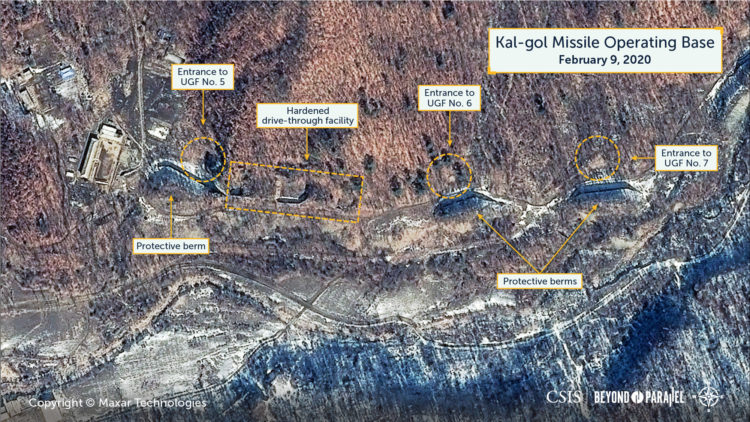
A close-up view of the hardened drive-through missile checkout facility and UGF entrance No. 5, December 3, 2019 (Copyright © 2020 by Maxar Technologies) 
A close-up view of UGF entrances Nos. 6 and 7, December 3, 2019 (Copyright © 2020 by Maxar Technologies)
The hardened drive-through missile checkout facility has been present in all imagery since 2000 and was likely also constructed during the initial conversion into a missile base. It is located between the first two UGF entrances and measures approximately 90-meters-by-15-meters overall with two earth-covered shelters separated by an open bay. It is unclear if there are additional entrances to UGFs under these shelters, but this would not be unusual. Such drive-through facilities are reportedly used by KPA missile units for maintenance, fueling, arming, and final checkout. There are also several nearby support buildings.

UGF entrances Nos. 8-10 and the hardened drive-through missile checkout facility as seen on November 3, 2000. Note the shovel working on the berm in front of UGF No. 9. (Copyright © 2020 by Maxar Technologies) 
UGF entrances Nos. 8-10 and the hardened drive-through missile checkout facility as seen on April 9, 2010 (Copyright © 2020 by Maxar Technologies) 
UGF entrances Nos. 8-10 and the hardened drive-through missile checkout facility as seen on February 9, 2020 (Copyright © CNES 2020, Distribution AIRBUS DS)

A close-up view of UGF entrance No. 8, December 3, 2019 (Copyright © 2020 by Maxar Technologies) 
A close-up view of UGF entrances Nos. 9 and 10 on November 3, 2000 showing what appears to be a shovel in front of entrance No. 9 (Copyright © 2020 by Maxar Technologies) 
A close-up view of UGF entrances Nos. 9 and 10, December 3, 2019 (Copyright © 2020 by Maxar Technologies)
Even though the UGF entrances and the hardened drive-through missile checkout facility are located on the north side of the valley they are frequently difficult to easily identify in satellite imagery during spring and summer due to the growth of trees and vegetation. Identification during late-fall or in winter (especially after a snow fall) is less challenging.
At the upmost reaches of the valley is a small support facility that has been present in all imagery since 2000. At that time, it appeared to have some of the characteristics of a small petroleum, lubricant and oil (POL) cradle tank facility. If so, it may have been a remnant of the original “Chilchon Military Barracks East” as subsequent imagery from April 15, 2005 shows that it has been razed and what appears to be an agricultural support facility erected. Imagery shows that several additional agricultural support structures (including a greenhouse) were constructed in the area during 2010-2011 and that an additional structure was built during 2019.

The small support facility at the uppermost reached of the valley. It has some of the characteristics of a small petroleum, lubricant and oil (POL) cradle tank facility. November 3, 2000 (Copyright © 2020 by Maxar Technologies) 
The original support facility has been razed and an what appears to be agricultural support facility erected, April 15, 2005 (Copyright © 2020 by Maxar Technologies) 
The agricultural support facility as seen on February 9, 2020 (Copyright © CNES 2020, Distribution AIRBUS DS)
Back down the valley, at the point where the main base begins, a branch valley splits off to the south across the Koksan-chon up towards the village of No-hyon that provides agricultural support. At the base of this southern branch valley both a barracks and support facility were constructed between 2000 and 2005. Since that time both facilities have been gradually expanded.

The area where barracks and support facilities would be built by 2005, November 3, 2000 (Copyright © 2020 by Maxar Technologies) 
The new barracks and support facilities as seen on April 15, 2005 (Copyright © 2020 by Maxar Technologies) 
The new barracks and support facilities as seen on February 9, 2020 (Copyright © CNES 2020, Distribution AIRBUS DS)
Further up southern branch valley is the agricultural hamlet of No-hyon. Here, a small tunnel connects west to the village of Chiram-dong (칠암동). Construction of this tunnel began sometime prior to 2000 and was likely completed around 2003. Imagery suggests that this tunnel is rarely used.
Approximately 500 meters up the southern branch valley a small support facility was present in 2000 imagery. This facility would slowly expand and sometime around 2006, what appear to have been four TEL field revetments were observed just south of the facility. These revetments subsequently fell into disuse although sometime during 2014-2015 the southernmost one was converted into a 25-meter-long earth covered bunker.
Constructed sometime during 2012-2014, in the wake of Kim Jong-un’s ascension to power, a second hardened missile checkout facility was built immediately west of the existing support facility. Similar to the first hardened drive-through missile checkout facility, this second facility measures approximately 100-meters-by-10-meters overall and consists of two earth-covered shelters separated by an open bay. It is unknown if there are entrances to UGFs beneath the earth-covered shelters.

This November 29, 2017 image shows the second hardened drive-through missile checkout facility, small support facility and that the southernmost TEL revetment has been converted into a small bunker (Copyright © 2020 by Maxar Technologies) 
Close-up view of the second hardened drive-through missile checkout facility, access road and adjacent support area, November 29, 2017 (Copyright © 2020 by Maxar Technologies) 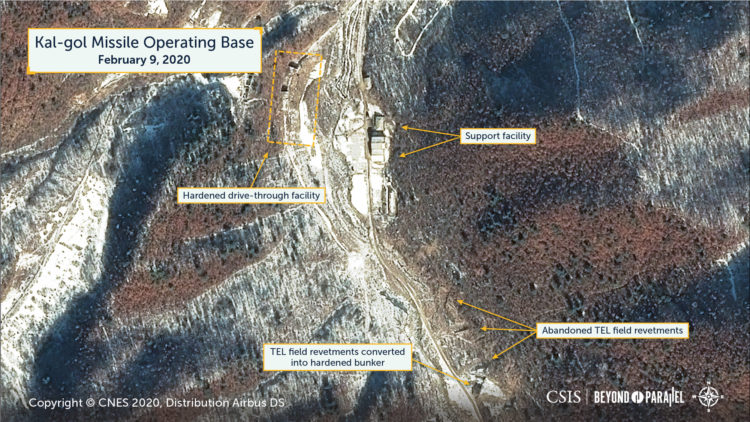
The second hardened drive-through missile checkout facility and support facility as seen on February 9, 2020 (Copyright © CNES 2020, Distribution AIRBUS DS)
Order-of-Battle28
Published information concerning the size and organization of the missile unit based at Kal-gol is inconsistent. This is likely due to both challenges in transliteration and that preliminary data suggests that KPA ballistic missile organizational structures may not neatly fit into western organizational structures, with units described as being larger than a regiment but smaller than a brigade, or larger than a battalion but smaller than a regiment, the term regiment and brigade being used interchangeably, etc.29 Regardless, the current archive of available high-resolution satellite imagery dating to 2000 provides some potential indicators upon which to base a preliminary assessment,
- A satellite image from November 29, 2017 shows approximately 1,100-1,300 troops in parade formation in the courtyard of the base headquarters (this figure excludes other personnel seen in the courtyard and around the base in the same image)
- The presence of two hardened drive-through missile checkout facilities with small support facilities and what appears to be a third drive-through facility erected during 2019
- A specialized drive-through maintenance and training building with arched clearstory
- Six large and four smaller underground facilities
These indicators, when combined with interview data and open source information suggests that the Kal-gol missile base houses a reinforced missile brigade with 9-12 TELs/MELs (with 27 to 36 missiles), support units and attached training and maintenance units.30 By comparison, a Cold-war era Soviet 9K72 Elbrus (NATO: SS-1C Scud B) had a personnel strength of approximately 1,000-1,400 and nine TELs.31
Should the missile unit based at Kal-gol be reequipped with more recently emerging solid rocket motor MRBMs (e.g., Pukkuksong-2) it would likely transition to an organizational structure consisting of three launch battalions, each with six launchers (a total of 18 launchers).32 If, however, it were reequipped with the new KN-23/-24/-25 solid rocket motor SRBMs it is likely that the organizational structure would lean towards that of a heavy multiple launch rocket system (MLRS) brigade.
“What’s In a Name?”33
The romanization of Korean place names is frequently challenging and often results in great confusion and the references to a missile unit operating in the Kal-gol area or specifically to the Kal-gol missile operating base are no exceptions to this phenomenon. Among the commonly used alternative romanizations for Kal-gol are: Gal-gol, Gal-kol, Galgol, Galkol, Kakgol, Kal-kol, Kalgol, and Kalkol.
These romanization challenges are made even more formidable by the fact that the Kal-gol missile operating base is located in the area where four counties and two provinces meet. Disambiguation of reported ballistic missile operating bases in or near the following locations indicate that they are all referring to the ballistic missile unit operating out of the Kal-gol base,
- Northeast Hwanghae-bukto (황해북도, North Hwanghae Province) or southern Kangwon-do (강원), Kangwon Province)
- The counties of Pangyo-gun (판교군, Pangyo County, Kangwon Province), Ichon-gun (이천군, Ichon County, Kangwon Province), Koksan-gun (곡산군, Koksan County, North Hwanghae Province) or Singye-gun (신계군, Singye County, North Hwanghae Province)
- The small cities of Chiha-ri (지하리), Singye (신계), Koksan (곡산) or To-gol (터골),34
Often cited references to a ballistic missile base at Kal-dong, Kalgol-dong, Kalgol-tong, Galgol-dong or Galkol-dong in Huichon-si (회천시, Huichon City) or Chonchon-gun (전천군, Chonchon County), both in Chagang-do (자강도, Changang Province), while often confused with the Kal-gol missile operating base, appear to be related to ballistic missile related research, development or production activities at the Huichon General Machine Tool Plant or No. 38 Plant (Huichon Youth Electric Complex) in Huichon-si that are adjacent to Kalgol-tong. Confusingly, some published sources have continued to identify the Kal-gol missile operating base as being in either Kalgol-dong, Huichon-si, Chagang-do, or To-gol, Hwanghae-bukto as late as 2018.35
Finally, it should be understood that the names of small North Korean towns, villages and hamlets often represent areas as opposed to precise points. So that there may be homes or farms at the precise coordinates cited, another cluster of homes and farms a short distance away is considered to be part of the same named town, village or hamlet. Additionally, over the years different sources refer to the same location by different names. For consistency and ease of reading, all location names used in this report are those currently accepted by the U.S. National Geospatial Intelligence Agency.
Research Note
This report, as are the others in this series, is based upon an ongoing study of the Korean People’s Army ballistic missile infrastructure begun by Joseph S. Bermudez Jr. in 1985. This study is based upon numerous interviews with North Korean defectors, government, defense, intelligence officials around the world, as well as declassified documents and open source reporting. Accuracy in any open source discussion of North Korea’s nuclear, biological, chemical, or ballistic missile programs is always a challenge and while some of the information used in the preparation of this study may eventually prove to be incomplete, or incorrect, it is hoped that it provides a new and unique look into the subject. The information presented here supersedes or updates previous works by Joseph S. Bermudez Jr. on these subjects.36
Although 35 high- and medium-resolution satellite images were analyzed during the preparation of this report, the images ultimately presented in this report were purposely selected for their detailed or historical view of the structures and activities within and around the Kal-gol missile operating base.
References
- The authors wish to thank Seiyeon Ji, program manager in the CSIS Korea Chair and Millie Heeu Kim and Seung Yeon Sunny Lee, former interns in the CSIS Korea Chair, for their invaluable assistance in support of this project. ↩
- Both the national designator for the missile operating base at Kal-gol and the KPA unit based there are unknown and North Korea is not known to have ever made specific references to either’s existence. The first reference to the use of the Kal-gol designation known to the author occurred in 1990 during the author’s conversations with defense and intelligence officials. ↩
- Interview data acquired by Joseph S. Bermudez Jr.; Yi Yo’ng-chong: “Taepo Dong-2 Manufactured at Namp’o on Its Way in Camouflage to Launch Site,” JoongAng Ilbo, June, 20, 2006; and Hwang, Yang-joon. “North Korea Builds Six Bases for 550 km-range Missiles,” Hankook Ilbo, October 27, 1999. ↩
- Interview data acquired by Joseph S. Bermudez Jr.; “Real Name!” July 16, 2017, http://www.neams.ru/real-name/; Ballistic and Cruise Missile Threat, (Wright-Patterson Air Force Base: National Air and Space Intelligence Center), June 2017, pp. 18-25; Yi Yo’ng-chong: “Taepo Dong-2 (Missile) Manufactured at Namp’o on Its Way in Camouflage to Launch Site,” JoongAng Ilbo, June, 20, 2006; “ROK Weekly Views ROK-US ‘Perception Gap’ Toward DPRK Military,” Chugan Choson, April 10, 2001, No. 1648; “ROK Defense Ministry Claims DPRK Building Missile Power as World Debates US Plan,” Chungang Ilbo, March 12, 2001, p. 2; “Expansion of North Scud Missile Base,” Joongang Ilbo, March 5, 2001, https://news.joins.com/article/4045601; “ROK Daily Views DPRK Missile Buildup,” Kyonghyang Sinmun, March 4, 2001; Hwang, Yang-joon. “North Korea Builds Six Bases for 550 km-range Missiles,” Hankook Ilbo, October 27, 1999; “North Korea, 3 Locations Along MDL Deployment Preparation,” Chosun Ilbo, September 29, 1999, http://news.chosun.com/svc/content_view/content_view.html?contid=1999092970058. ↩
- It is unlikely that the missile unit at Kal-gol would be equipped with the Nodong-1/-2 as production of these systems appears to have been completed and almost all are already deployed at other bases in the rear areas. Additionally, the Scud-ER is simpler and less expensive to construct than the Nodong. Interview data acquired by Joseph S. Bermudez Jr.; and A Primer on the Future Threat, The Decades Ahead: 1999-2020, (Washington, D.C.: Defense Intelligence Agency), July 4, 1999, pp. 79-80. ↩
- Aside from the specific references cited below more general references to this deployment include: Jun Kyung-woong. “Dissecting North Korea’s tactics and military strength…this is how North Korea conducts military provocations,” Future Korea, November 15, 2018; Yu Yong-won, “North Korea’s Ballistic Missile Bases, 13 Locations Among 3 Belts,” Chosun Ilbo, November 14, 2018, http://news.chosun.com/site/data/html_dir/2018/11/14/2018111400327.html; Kwon Soon-hwal. “North Korea Secretly Expanding Its Missile Facilities,” Donga Ilbo, September 9, 1998, https://www.donga.com/news/article/all/19980909/0002248794/1; and Poltov, A. “Secret Underground Missile Base Set Up in East DPRK,” Tokyo Shimbun, September 8, 1998, p. 7. ↩
- Interview data acquired by Joseph S. Bermudez Jr.; “Expansion of North Scud Missile Base,” Joongang Ilbo, March 5, 2001, https://news.joins.com/article/4045601; Kang Ho-sik. “North’s Missiles Increase. Strategic, Forward Deployment Both in and Out,” Kyunghyang Shinmun, March 5, 2001, https://www.bigkinds.or.kr/news/newsDetailView.do?newsId=01100101.20010305000000301; Osamu Eya, Great Illustrated Book of Kim Chong-il, (Tokyo: Shogakukan, 2000), pp. 10-15; “Defector Says Long-Range Missile Bases Built,” KBS-1, August 24, 1993; and “Newspaper Reports North’s Scud Missile Deployment,” Seoul Sinmun, February 24, 1992, p. 8. ↩
- While the “Chilchon Military Barracks East + Mech Infantry Bn” was located at approximately 38.682288, 126.722600 (today’s Serim-ni), the name is a reference to the village of Ch’ilchon-dong to the west. Interview data acquired by Joseph S. Bermudez Jr.; Central Intelligence Agency. Annual Index, Photographic Exploitation Products, January-December 1982, Volume 4 of 5 Volumes, May 1983, p. 1095. ↩
- Interview data acquired by Joseph S. Bermudez Jr.; and “Defense Ministry: May Nodong-1 Test Successful,” Yonhap, 24 June 1993. ↩
- It may be that elements of the Kal-gol Scud ballistic missile unit were provisionally based in these areas before moving into the base itself. ↩
- See note 5 above for a discussion on the use of T’o-gol. Gertz, Bill. “North Korean Missile Apparently Blows Up,” Washington Times, Thursday, July 5, 1990,” p. A4; and Yu Yong-won. “The Hyonmu Versus the Scud,” Wolgan Choson, April 1991, pp. 378-93. The original and subsequent reports appear to conflate the Hwasong-6 (Scud C) and the Hwasong-7 (Nodong). ↩
- Ibid. ↩
- Interview data acquired by Joseph S. Bermudez Jr.; Beyond Parallel is preparing a report on the Kittae-ryong base. “N Korea Test Fires ‘Scud C’,” Jane’s Defence Weekly, October 12, 1991, p. 651; “North Said To Develop Scud Mobile Launcher,” Yonhap, October 4, 1991, and “North Korea-Missile,” Associated Press, October 4, 1991. ↩
- “Security Planning Agency Views DPRK’s DMZ Redeployments,” Chungang Ilbo, February 9, 1996, p. 2. ↩
- Interview data acquired by Joseph S. Bermudez Jr. ↩
- Kim Jong-hoon. “Defense Ministry publishes ‘99 White Paper – North Korean troops increase by one million, now at 1.17 million,” Kyunghyang Sinmun, October 13, 1999; Kim Kui-keun, “Changes in North Korea’s military power – Defense White Paper,” Yonhap, October 12, 1999; Yu Yong Won, “North, Solely Taking Care of Its Arsenal Despite of Famine,” Chosun Ilbo, 29 September 1999, p. 2; “N. Korea Sells 800 Mil. Dlrs in Weapons in 8 Years,” Japan Economic Newswire, 28 September 1999; and “ROK Official Comments on DPRK Missile Plants, Bases,” Yonhap, March 25, 1999. ↩
- Chu Yong Chung, “Comprehensive: 200 Scud C missiles with 500 km range, North Korea prepares deployment to 3 locations,” Chosun Ilbo, September 29, 1999. ↩
- Hwang Yang-joon. “South Korean Military Authorities: North Korea Builds Six Bases For 550 km Range Missiles,” Hankook Ilbo, October 27, 1999. ↩
- Kim Min-suk. “North Korea continues expansion of missile base,” JoongAng Ilbo, March 6, 2001, https://news.joins.com/article/4045753. ↩
- Yi Yo’ng-chong: “Taepo Dong-2 (Missile) Manufactured at Namp’o on Its Way in Camouflage to Launch Site,” JoongAng Ilbo, June, 20, 2006. ↩
- Bermudez Jr., Joseph S. and Nathan J Hunt, “North Korean Missile Base Shows Operational Focus: Base Expansion,” Jane’s Intelligence Review, August 24, 2018, pp. 44-47; and Bermudez Jr., Joseph S. “Behind the Lines—North Korea’s Ballistic Missile Units,” Jane’s Intelligence Review, July 2011, pp. 48-53. ↩
- There are only small cultivated fields around the location where the village of Sangserim-dong once existed. It is likely that the village was razed during the construction of the base. ↩
- Ibid ↩
- Numerous defense and intelligence sources indicate that the more modern, and longer-ranged, missile systems such as the Hwasong-10, -13 -14 and -15 are deployed at missile bases within the Strategic Rear areas of the nation. Interview data acquired by Joseph S. Bermudez Jr. ↩
- An alternative interpretation would be a higher-level headquarters with a missile brigade and training and maintenance support elements. ↩
- The No. 65 Factory is sometimes referred to as the February 8 Machine Complex or 2.8 Machinery Complex. ↩
- Interview data acquired by Joseph S. Bermudez Jr.; United Nations Security Council. Report of the Panel of Experts, June 11, 2013, http://www.un.org/ga/search/view_doc.asp?symbol=S/2013/337; and Lewis, Jeffrey. “That Ain’t My Truck: Where North Korea Assembled Its Chinese Transporter-Erector-Launchers,” 38 North, February 3, 2014, http://www.38north.org/2014/02/jlewis020314/. ↩
- Bermudez Jr., Joseph S. and Nathan J Hunt, “North Korean Missile Base Shows Operational Focus: Base Expansion,” Jane’s Intelligence Review, August 24, 2018, pp. 44-47; and Bermudez Jr., Joseph S. “Behind the Lines—North Korea’s Ballistic Missile Units,” Jane’s Intelligence Review, July 2011, pp. 48-53. ↩
- Interview data acquired by Joseph S. Bermudez Jr. ↩
- Ibid. See note 22. ↩
- Opposing Forces-Europe, FM 30-102, (US Army: Washington, D.C., 1977), p. 13-6. By contrast a 1994 unclassified assessment the U.S. Defense Intelligence Agency credited a KPA Scud battalion with 173 personnel and 6 TELs. Defense Intelligence Agency. North Korea Handbook, 1993, p. 5-22. ↩
- Such an organization would likely be similar to that of the former Soviet 9K79 Tochka (NATO: SS-21 Scarab) brigade. For example, see: “WGF Still Has Nuclear SSMS,” Jane’s Defence Weekly, June 22, 1991, p. 1081; and “442nd Missile Brigade,” http://www.ww2.dk/new/army/rbr/442rbr.htm. ↩
- The information presented in this section is continuing to be refined and updates will be published as required. ↩
- In relation to the Kal-gol base, Chiha-ri is 6.6 kilometers to the southwest, Koksan is approximately 12 kilometers to the northwest, Sin’gye is approximately 25 kilometers to the southwest and T’o-gol is approximately 15 kilometers to the southwest. Previous assessments that all references to T’o-gol were actually referring to the Sakkanmol missile operating base are incorrect. Confusingly, only some of these references are to that base. Sakkanmol is in Sohŭng-gun (서흥군) and 47 kilometers west of the T’o-gol in Sin’gye-gun and an unlikely candidate. There is, however, another identically named T’o-gol (sometimes T’o-kol) 9.5 kilometers to the northeast (38.643333, 126.189722) of the Sakkanmol base in Sohŭng-gun, which is where the likely confusion arises. There is, however, no ballistic missile base at this T’o-gol. ↩
- For example, see: Son Hyo-joo. “Government: Remained Silent so North Korea would not notice surveillance,” Dong-a Ilbo, November 15, 2018, http://news.donga.com/3/all/20181115/92877807/1; Lee Young-jong. “Taepodong No. 2, Built in Nampo, Is Camouflaged and Moved to Launch Site,” Joongang Ilbo, July 7, 2006, https://news.joins.com/article/2329379; Jun Kyung-woong. “Dissecting North Korea’s tactics and military strength…this is how North Korea conducts military provocations,” Future Korea, November 15, 2018; and Hwang Yang-joon. “North Korea Builds Six Bases for 550 km-range Missiles,” Hankook Ilbo, October 27, 1999. ↩
- For example: Bermudez Jr., Joseph S. and Nathan J Hunt, “North Korean Missile Base Shows Operational Focus: Base Expansion,” Jane’s Intelligence Review, August 24, 2018, pp. 44-47; and Bermudez Jr., Joseph S. “Behind the Lines—North Korea’s Ballistic Missile Units,” Jane’s Intelligence Review, July 2011, pp. 48-53. ↩


